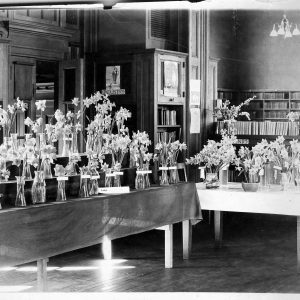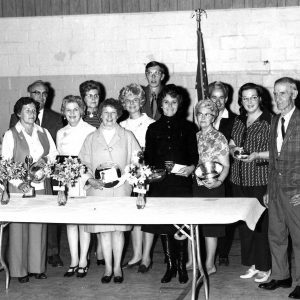Takoma Horticultural Club
A hardy perennial since 1916
IV. Flower Shows
Where have all the flower shows gone? Not so long in passing.

Flower show is a misnomer—per earlier versions of the THC constitution, they were “exhibitions and demonstrations at the proper seasons to promote horticultural appreciation.” And, they were much more than flowers: fruits and vegetables, houseplants, artistic arrangements, and even garden plots were shown and awarded prizes.
THC lost no time in staging exhibitions. In April 1916, one month after its founding, the club held the first narcissus show in the Takoma, DC library. Founding member Dr. David Griffiths brought the blooms from the grounds of the Department of Agriculture at Arlington, as there were “few cultivated flowers grown in Takoma Park.” Another founding member supplied the vases: bottles discarded by the Office of Foreign Seed and Plant Introduction of the USDA. Club members became “aware of the possibilities enclosed in the unsightly bulbs,” and before the year was out, they staged four more shows of tulips, iris, and chrysanthemums as well as one with the Community Garden Club. Total attendance that year numbered 754 people.
Over the next few years, rose, peony, gladiola, dahlia, camellia, and winter household plants were added to the list of plant-specific exhibits. Azalea shows began after WWII. Seasonal vegetables were always part of the shows, but gradually gave way to predominantly flowers. In the club’s early years, there were as many as nine shows a year! By the second half of the century, these numbers declined and frequently exhibits were often combined (e.g., the 1958 show was the 41st annual tulip show, 6th annual azalea show, and 41st annual iris show in one). The Takoma, DC library remained the venue until 1950, when the shows moved to Takoma, DC Elementary school, then to Takoma Junior High School in 1962, and later to the Takoma Park Community Center. The Takoma Theatre and the Takoma Park Volunteer Fire Department were occasionally sites.
THC sometimes joined with DC-area plant societies in holding shows. Iris exhibitions in the 1940s were staged in cooperation with the American Iris Society. THC, the Silver Spring Garden and the Woodridge Garden Clubs sponsored the first National Capital Narcissus Show, and THC and Silver Spring were partners in a National Tulip Show in 1950. Members of THC won the National Capital Dahlia and Iris Society Cup in 1934, and for four consecutive years in the 1940-50s, the Club took home the Blackstone Bowl, awarded at the annual fall show of the Potomac Rose Society to the Club whose members won the highest total number of points in the show.
Orchestrating a THC flower show was something of a three-ring circus. Shortly after the first narcissus show, a member urged the club to learn from his observations at a rose show he attended in Washington, DC. It was “thoroughly organized,” and THC should “plan all our exhibitions well in advance of being held.” THC quickly drew up its detailed rules for exhibits in the same year. Scores of members and other volunteers were required. In addition to the THC standing exhibition committee (typically 6 – 12 members), each show had a lengthy list of tasks to be fulfilled by one or more people: judging (at least three for each genus of flower and two for artistic arrangements); judges’ aides (one for each judge); registration of entrants; publicity; hosting; scheduling; staging; classifying (determining the species and class—by flower color or other characteristic); publicizing; purchasing awards; tabulating points awarded; and setting up and taking down. A show with three types of flowers plus artistic arrangements could have up to 100 classes of entries, with many entrants in each class.
Shows had seasonally themed titles such as “Leap into spring,” “Spring splendor,” and “The miracle of spring.” The artistic arrangement category was also themed, with each class of arrangement representing an aspect of the theme. One year the theme was “the home,” and classes included living room picture window, father’s study, daughter Betty, Bud’s hobby room, and breakfast nook. A fall show included the arrangement classes of moonlight on the patio, fishing, drifting along, just resting, and married harmony. The artistic arrangement category also included classes for juniors, “inter-club,” novice, and by-invitation.
Prizes included first, second, and third place ribbons as well as items purchased from or donated by local garden shops—plants, a sprayer, shears, pruners, and saws, for example. The most treasured awards were trophies for very specific achievements. Some were “perpetual trophies,” established by or in memory of a club member. The annual winner had his or her name engraved on it, kept it a year, and then surrendered it for a miniature. Among them were the Winn T. Simmons (an early club president) Trophy for the most blue ribbons in all flower shows during a year; the Albertson Trophy for the best collection of four named varieties of roses—yellow, white, red, and pink; the Oliver E. Sweet Trophy for the best collection of six different varieties of floribundas and/or polyanthas (but not grandifloras); and the Gertrude Harrison Trophy for the most blue ribbons in artistic arrangements.

Flower shows continued through the 1990s, but club membership was dropping—and the tasks associated with the shows were complex and time consuming. By 1999, the Chairperson of the Exhibits Committee was calling for people to “bring whatever flower makes them happy and enter it in the show.” THC entered the 21st century with nary a word about flower shows.
Although THC’s flower shows are no more, some pieces of the exhibits’ history still remain (although the whereabouts of the perpetual trophies remain a mystery). A few fortunate current club members have in their possession the vases and/or their wood storage boxes, purchased in 1918 with a $10 award from the now out-of-business Woodward and Lothrop at $3.00 for 100 vases. These were used through the last of the shows. The Club is also privileged to have on loan a set of colorful hand-sewn banners, made by long-time member Mickie Riley in the late 1980s. These will be displayed as part of the THC centennial exhibit at Historic Takoma, Inc.
